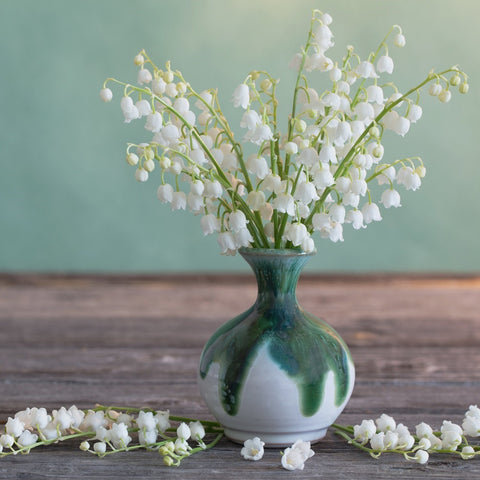Legend says that when the lily of the valley blooms, happiness returns. Its lovely arching sprays of small white, bell-shaped flowers traditionally represent purity and humility, and are a favorite in bridal bouquets. While we can’t guarantee that our lilies of the valley will change your life, their blossoming sweet fragrance surely lifts your spirit. Indoors, their scent brings spring into the room.

Beauty and Low Maintenance
Lily of the valley’s delicate beauty belies its ease of care. It’s an adaptable plant, preferring moist soil and partial shade, but learns to thrive in dry, shady areas. If there’s a shady spot in your yard begging for an attractive groundcover, lily of the valley provides a fragrant solution. For best results, though, keep your lily of the valley well-watered. In cold winter climates, zones 2-8, lily of the valley will naturalize readily. In warmer winter areas, such as Southern California and the Deep South, gardeners must treat lily of the valley as an annual, or plan for extensive digging and chilling every year. To learn more about how to plant your lily of the valley, read our planting guide.
Mature Pips
Lily of the valley doesn’t grow from bulbs, but from rhizomes called “pips”. Once planted, the pips quickly extend their roots underground, creating abundant groundcover.
We are happy to provide our customers with 2-year old blooming lily of the valley pips in both white and pink, while most companies have only 1-year old planting pips available (often referred to as “planting pips”, or “groundcover pips”, as opposed to the mature “flowering pips”. Two-year old pips are mature enough to flower the first season, while just 22 percent of 1-year old pips bloom their first spring in your garden. These 2-year old flowering pips can be forced indoors for sweetly scented blooms in just weeks (a detailed post on this is coming soon!). We also have 1-year old planting pips available, and they’re a great way to get an economical start on a mass planting.
Keeping Lily of the Valley in Place
Because lily of the valley spreads so easily, plant it where you know you will enjoy it! Use metal flashing as a divide in the bed. Keep most of the flashing buried below the soil line, perhaps 4 inches above the soil. This is a good method of keeping lily of the valley surrounded and contained inside a bed that doesn't have hardscape boundaries.
Gardens or Containers
While lily of the valley makes an excellent choice for a less formal, natural garden, it also proves an attractive container plant. Perfect for patios, lily of the valley’s spread is not an issue when confined to a planter.
Pink Lily of the Valley
Add an uncommon and exquisite note of color to your lily of the valley bed by incorporating this variety, Convallaria rosea. Our 2-year old pips will bloom in their first season. Like all very rare, beautiful items, pink lily of the valley is correspondingly expensive. Treat yourself – and your garden – to these fragrant, graceful flowers.
Best Effects
Pink lily of the valley shows best when interplanted with the white variety, so the contrast plays well with the color. Otherwise, the pale pink may not appear “pink” in the shade without the color contrast with the bright white. Like the white version, pink lily of the valley spread easily, soon forming a charming, scented groundcover with wide, lush foliage, and thrives in shady gardens. To establish a large planting, the 1-year old groundcover pips are an economical way to get a large planting started without breaking the bank.
Shade and Container Lovers
Like the familiar white lily of the valley, the pink adapts well to various soil and sun conditions, thriving in moist, partly shady areas of the garden. However, it will tolerate some sun and drier soils, and will bloom successfully in these conditions. Once planted, it’s quite low maintenance, although it does tend to spread. In cold winter climates, lily of the valley is a perennial, but gardeners in mild winter parts of the country should treat it as an annual.
As expected, pink lily of the valley can also flourish in containers and planters. A tub of these delicate blossoms provides a lovely accent to your patio or deck, and is an ideal choice for mixing with other specimens, adding subtle, pale pink touches to the blend. Make sure to refer to our lily of the valley planting guide so you can add a blush of color to your indoor or outdoor garden.
Drought and Deer Tolerant
Lily of the valley’s fragile beauty belies its inherent toughness. While lily of the valley prefers moisture, it can pull through drought. Deer don’t care for it, and neither do rabbits. That makes it an excellent choice in yards frequented by plant-devouring wildlife. That’s because it’s toxic, so don’t allow pets and small children access to lily of the valley. This plant protects itself! Lily of the valley – pink or white – isn’t susceptible to many diseases, and can become a mainstay of your garden for many years.

Remember to check back for more tips on how to plant these pips, as well as other flower varieties, in upcoming blogs.

